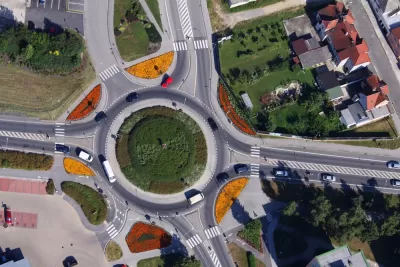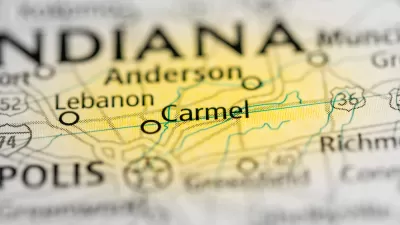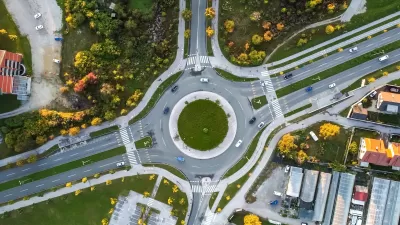Roundabout are gaining popularity in California and across the nation. While they have been shown to reduce crashes, not all are sold on the innovative concept, and when it comes to multi-lane roundabouts, cyclists have legitimate concerns.

If transportation planners have their way at various intersections inside and outside Napa's city limits, roundabouts will be replacing traffic signals and even a "a planned high-speed connection between Highways 29 and 221 could see a towering flyover ramp replaced by yet another pair of roundabouts," writes Howard Yune for the Napa Valley Register.
The Federal Highway Administration (FHWA) describes the modern roundabout as a counterclockwise hub designed to keep motor vehicles moving slowly, but always moving, usually at 15 to 25 mph: faster than neighborhood traffic circles, but slower than the wide-radius rotaries seen in parts of the Northeast.
The definition misses the crucial 'splitter islands' necessary for safer use by pedestrians and cyclists. See page 31/55 of Chapter 6, Geometric Design (of Roundabouts), FHWA (PDF): 6.3.8 Splitter islands
Splitter islands (also called separator islands or median islands) should be provided on all roundabouts, except those with very small diameters at which the splitter island would obstruct the visibility of the central island. Their purpose is to provide shelter for pedestrians (including wheelchairs, bicycles, and baby strollers), assist in controlling speeds, guide traffic into the roundabout, physically separate entering and exiting traffic streams, and deter wrong-way movements. Additionally, splitter islands can be used as a place for mounting signs (see Chapter 7).
State policy backs roundabouts
"Starting in the early 2000s, California began requiring cities and counties to consider roundabouts as one option for any state highway intersection where traffic lights are proposed, records show," writes Yune. "The state expanded its mandate in 2013 to projects involving reconstruction, widening or interchange fixes."
California may be home to about 300 roundabouts, though that number likely includes older crossings without all the features of newer connections, according to Jerry Champa, a liaison for Caltrans traffic operations.
But the state trails the nation in adopting roundabouts, with 3,500 to 5,000 estimated nationwide, writes Yune.
Safety
The real value of roundabouts lies in their ability to turn potentially deadly or devastating broadside strikes into slower and less dangerous fender-benders, according to Eugene Russell, a civil engineering professor at Kansas State University and a longtime advocate of the design.....
Largely by eliminating left turns, roundabouts reduce the rate of crashes causing death or serious injury by 78 to 82 percent, compared to crossings governed by signals or stop signs, according to Federal Highway Administration.
However, not all are sold in Napa on the safety value of roundabouts. The Napa Valley Bicycle Coalition took exception to two-lane roundabouts.
Two-lane sections in particular would leave those on bikes vulnerable to sudden lane changes by drivers unfamiliar with roundabouts, said Patrick Band, executive director of the Napa County Bicycle Coalition.
The Pedestrian and Bicycle Information Center, funded by the FHWA, backs up that assertion, though not entirely. "Multi-lane roundabouts that would be found on multi-lane roadways are not going to make these corridors work better for cyclists or pedestrians, but their lower operating speeds have some advantage," they conclude.
Hat tip to MTC-ABAG Library.
FULL STORY: Roundabouts are coming, but do they work?

Planetizen Federal Action Tracker
A weekly monitor of how Trump’s orders and actions are impacting planners and planning in America.

Map: Where Senate Republicans Want to Sell Your Public Lands
For public land advocates, the Senate Republicans’ proposal to sell millions of acres of public land in the West is “the biggest fight of their careers.”

Restaurant Patios Were a Pandemic Win — Why Were They so Hard to Keep?
Social distancing requirements and changes in travel patterns prompted cities to pilot new uses for street and sidewalk space. Then it got complicated.

Albuquerque Route 66 Motels Become Affordable Housing
A $4 million city fund is incentivizing developers to breathe new life into derelict midcentury motels.

DC Area County Eliminates Bus Fares
Montgomery County joins a growing trend of making transit free.

Platform Pilsner: Vancouver Transit Agency Releases... a Beer?
TransLink will receive a portion of every sale of the four-pack.
Urban Design for Planners 1: Software Tools
This six-course series explores essential urban design concepts using open source software and equips planners with the tools they need to participate fully in the urban design process.
Planning for Universal Design
Learn the tools for implementing Universal Design in planning regulations.
Heyer Gruel & Associates PA
JM Goldson LLC
Custer County Colorado
City of Camden Redevelopment Agency
City of Astoria
Transportation Research & Education Center (TREC) at Portland State University
Camden Redevelopment Agency
City of Claremont
Municipality of Princeton (NJ)





























